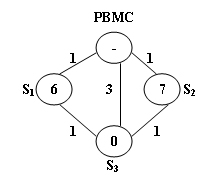There is a public bike service in Hangzhou City which provides great convenience to the tourists from all over the world. One may rent a bike at any station and return it to any other stations in the city.
The Public Bike Management Center (PBMC) keeps monitoring the real-time capacity of all the stations. A station is said to be in perfect condition if it is exactly half-full. If a station is full or empty, PBMC will collect or send bikes to adjust the condition of that station to perfect. And more, all the stations on the way will be adjusted as well.
When a problem station is reported, PBMC will always choose the shortest path to reach that station. If there are more than one shortest path, the one that requires the least number of bikes sent from PBMC will be chosen.

The above figure illustrates an example. The stations are represented by vertices and the roads correspond to the edges. The number on an edge is the time taken to reach one end station from another. The number written inside a vertex S is the current number of bikes stored at S. Given that the maximum capacity of each station is 10. To solve the problem at S3, we have 2 different shortest paths:
PBMC -> S1-> S3. In this case, 4 bikes must be sent from PBMC, because we can collect 1 bike from S1and then take 5 bikes to S3, so that both stations will be in perfect conditions.
PBMC -> S2-> S3. This path requires the same time as path 1, but only 3 bikes sent from PBMC and hence is the one that will be chosen.
Input Specification:
Each input file contains one test case. For each case, the first line contains 4 numbers: C
max
(≤100), always an even number, is the maximum capacity of each station; N (≤500), the total number of stations; Sp, the index of the problem station (the stations are numbered from 1 to N, and PBMC is represented by the vertex 0); and M, the number of roads. The second line contains N non-negative numbers Ci(i=1,⋯,N) where each Ciis the current number of bikes at Si respectively. Then M lines follow, each contains 3 numbers: Si, Sj, and Tij which describe the time Tij taken to move betwen stations Si and Sj. All the numbers in a line are separated by a space.
Output Specification:
For each test case, print your results in one line. First output the number of bikes that PBMC must send. Then after one space, output the path in the format: 0−>S1−>⋯−>Sp. Finally after another space, output the number of bikes that we must take back to PBMC after the condition of Sp is adjusted to perfect.
Note that if such a path is not unique, output the one that requires minimum number of bikes that we must take back to PBMC. The judge’s data guarantee that such a path is unique.
dijkstra求每个点的前驱,再用dfs求满足条件的路径。主要是求从PBMC带出的自行车数need以及带回的自行车数back,感觉有点绕:某点多余的自行车数不能补充到其前驱各点,只能添加到这条路径上该点之后的点。这里参考了1018. Public Bike Management (30)-PAT甲级真题(Dijkstra + DFS),在输入时,各点自行车数减去cmax/2,根据正负判断是否需要补充自行车。
#include<iostream>
#include<vector>
using namespace std;
const int maxn = 510;
const int inf = 0x3fffffff;
int graph[maxn][maxn], cmax, n, sp, m, bikes[maxn], dis[maxn], mark[maxn];
vector<vector<int>>pre;
vector<int>path, tempPath;
int minNeed = inf, minBack = inf;
void dijistra() {
dis[0] = 0;
for (int i = 0; i <= n; i++) {
int pos = -1, min = inf;
for (int j = 0; j <= n; j++) {
if (mark[j] == 0 && dis[j] < min) {
pos = j;
min = dis[j];
}
}
if (pos == -1)break;
mark[pos] = 1;
for (int j = 0; j <= n; j++) {
if (mark[j] == 0 && graph[pos][j] != inf) {
if (dis[j] > dis[pos] + graph[pos][j]) {
dis[j] = dis[pos] + graph[pos][j];
pre[j].clear();
pre[j].push_back(pos);
}
else if (dis[j] == dis[pos] + graph[pos][j])
pre[j].push_back(pos);
}
}
}
}
void dfs(int v) {
if (v == 0) {
int need = 0, back = 0;
for (int i = tempPath.size() - 1; i >= 0; i--) {
int id = tempPath[i];
if (bikes[id] > 0)back += bikes[id];//带回多余的自行车
else {
if (back + bikes[id] > 0)back += bikes[id];//多余的自行车数可以补足不足的
else {//前面的点多出的自行车全部补充到该点,缺额从PBMC带来
need += -(bikes[id] + back);
back = 0;
}
}
}
if (need < minNeed) {
minNeed = need;
minBack = back;
path = tempPath;
}
else if (need == minNeed && back < minBack) {
minBack = back;
path = tempPath;
}
return;
}
tempPath.push_back(v);
for (int i = 0; i < pre[v].size(); i++) {
dfs(pre[v][i]);
}
tempPath.pop_back();
}
int main() {
cin >> cmax >> n >> sp >> m;
pre.resize(n + 1);
for (int i = 1; i <= n; i++) {
cin >> bikes[i];
bikes[i] -= cmax / 2;
dis[i] = inf;
mark[i] = 0;
for (int j = 0; j <= n; j++)graph[i][j] = inf;
}
for (int i = 0; i <= n; i++)graph[0][i] = inf;
for (int i = 0; i < m; i++) {
int x, y, d;
cin >> x >> y >> d;
graph[x][y] = graph[y][x] = d;
}
dijistra();
dfs(sp);
cout << minNeed << " 0";
for (int i = path.size() - 1; i >= 0; i--)cout << "->" << path[i];
cout << " " << minBack << endl;
return 0;
}





 本文介绍了一种用于解决杭州城市公共自行车系统中车站容量失衡问题的算法。通过监测所有车站的实时容量,并确保每个车站处于半满状态,以提供最佳服务。当车站满载或空置时,公共自行车管理中心会调整车站状态。文章详细描述了如何选择最短路径并最小化自行车调度数量的策略。
本文介绍了一种用于解决杭州城市公共自行车系统中车站容量失衡问题的算法。通过监测所有车站的实时容量,并确保每个车站处于半满状态,以提供最佳服务。当车站满载或空置时,公共自行车管理中心会调整车站状态。文章详细描述了如何选择最短路径并最小化自行车调度数量的策略。
















 3576
3576

 被折叠的 条评论
为什么被折叠?
被折叠的 条评论
为什么被折叠?








